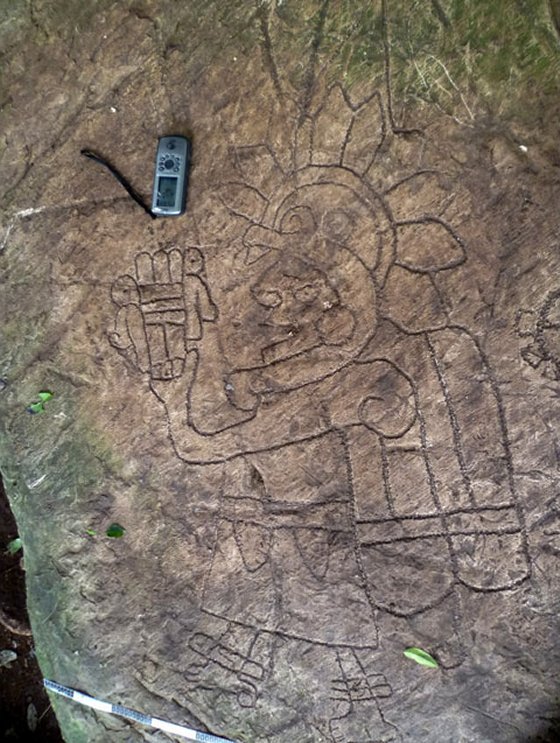MessageToEagle.com – Archaeologists from the National Institute of Anthropology and History (INAH) in Mexico are busy researching a set of petroglyphs discovered on the slopes of Cerro del Sombrete located in the northern part of Veracruz, among which the depiction of a priest or “wise man” is clearly seen.
This fascinating ancient depiction – 1.40 m high by 50 cm wide – is surrounded by the symbols related to time and astronomical elements.
The “wise man” or priest wears a zoomorphic helmet with a cape and underskirt decorated with triangles, a girdle and ankle bracelets and an ear plug. His mouth is open and his visible eye is closed.

In the upper part of the rock covered with depiction, there are two concentric circles similar to those holding the so-called “chalchihuitl” – precious green stone symbolizing “Heart of the Earth”.
“In his left hand – as we see, the only one visible – he wears a symbol that could represent a cane or a time glyph, also the rest of the scene is composed of four elements that can be interpreted as solar or astronomical connotations”, detailed Maria Eugenia Maldonado Vite.
Behind the character’s cape we can observe a shield divided into four quadrants with quadrangular motives in the lower part.
The sedimentary rock itself is 2.90 meters [6.84 feet] by 2.50 meters [6.72 feet] and is estimated to be 500 years only, according
to the archaeologists.
According to Maria Eugenia Maldonado Vite, the archaeologist responsible for the registry of the discoveries, these cultural expressions could possibly be related to the art of “counting time”, the movement of heavenly bodies or a specific homage to the hills.
Based on the figure’s apparel and associated designs, researchers believe that it must represent a priest or a tlamatinime, which in language spoken by Nahua people means “wise man”.
This intriguing petroglyph is accompanied by another one, depicting much cruder anthropomorphic figure (50 cm high by 20 cm wide). This time, however, the figure – also wearing an ear plug – has mouth and eye open.
The figure seems to be dancing as its loincloth (máxtlatl) lifts up at the front.
Unlike the shaman, this figure is rather schematically drawn. No hands are represented and the feet seem to be wearing shoes.
“As far as we know, there hasn’t been a single petroglyph similar to it in Veracruz, which is why this representation, linked to the observation of nature and the art of “counting time”, is so important,” Maldonado Vite. points out.
What’s the meaning of these ancient depictions? Are they related to the cosmogony of societies that once inhabited the region?
First version of this article was originally published on April 29, 2013
© MessageToEagle.com






